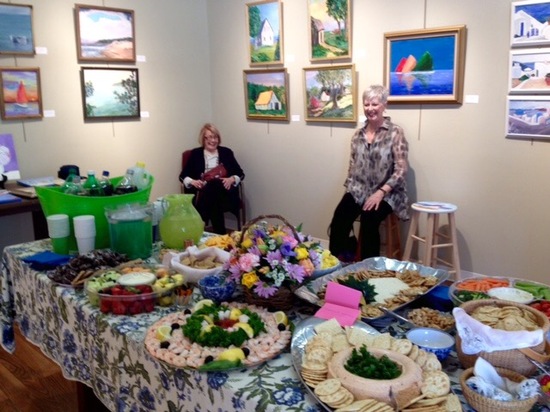A "first" for my mother came just days shy of her most recent significant birthday -- the exact number for which she does not want to see printed here. As I helped to set up her first major art gallery exhibit in Falmouth, Massachusetts, I marveled at how full of life she was, radiating joy as she showed her work to fellow artists, family and guests. The windswept beaches of her Cape Cod home, colorful harbors, cozy New England cottages, rolling hills and old barns -- she transformed her life experiences into beautiful works of oils and acrylics.
After moving to Germany over 65 years ago when my father served in the army, my mother took painting lessons for the first time from a local painter in Stuttgart. But her newfound hobby was set aside to raise her four children, and then resume her career as a registered nurse for 30 years -- she was recently honored at a ceremony at NIH for service in the U.S. Cadet Nurse Corps in World War II. But she never forgot her love for painting and dreamt of picking up her paintbrush again once her life settled down a bit...at the age of 80, after easing back in through some fun with stained glass.
"Painting has made me see things differently and more clearly," she's said. Whether it's taking pictures of architecture and landscapes to inspire future paintings, showcasing her work at the Mashpee Public Library or taking art classes, my mother is always on the go. In fact, my siblings and I find it quite hard to keep up.
My mother, Evelyn Lynch (left) and my partner, Dianne Brace, thought there should be some snacks at the opening.
This vitality is consistent with findings from decades of pioneering work in the research, policy and practice of arts and aging. Participation in the arts has been shown to improve cognitive function and memory, general self-esteem and well-being, as well as reduce stress and common symptoms of dementia, such as aggression, agitation and apathy.
Creativity can be nurtured throughout life, and the older brain, rich in life experiences, can be stimulated to create and contribute in extraordinary ways. The field of creative aging acknowledges the vital link between creativity and quality of life for older adults, regardless of economic status, age or level of physical, emotional or cognitive functioning.
Providing arts services for the aging population is gaining momentum, and it must continue to increase. The United States is in the midst of a major demographic shift. The U.S. Census Bureau projects that the population age 85 and older could grow from 5.5 million in 2010 to 19 million by 2050. By then, there will be more older people than school-age children. With advancements in healthcare technology, we can expect to live longer, healthier and more productive lives than ever before.
The National Center for Creative Aging (NCCA) was formed in 2001 -- by the National Endowment for the Arts, the National Council on Aging and Elders Share the Arts -- to communicate the vital relationship between creative expression and healthy aging, and to develop programs that build upon this understanding. NCCA's free online training for teaching artists covers topics such as the aging process, the creative potential of older adults and how to identify community partners in aging, arts and health-related services. A robust database makes it easy to discover a vast number of arts programs serving older people across the country.
It's wonderful to see programs cropping up everywhere, and success stories abound. When poet Gary Glazner received a small grant to give a series of workshops at an adult daycare center in Northern California, his only instruction was to use poetry. To inspire creativity, his idea was to use classic poems that the people might have learned as children. One man had his head down, not participating, and appeared to be completely unaware of his surroundings. When Gary recited the Longfellow poem "I shot an arrow in the air," the man's eyes popped open and he said, "It fell to earth, I knew not where." Suddenly he was back with the class and able to participate.
From that point, Gary was hooked. He began to see that even in the late stages of dementia, people can remember words and lines from poems they learned as children, and that this art form could be incredibly useful with this community. In 2004, Gary formed the Alzheimer's Poetry Project, and since then it has been using the power of poetry to awaken the minds and spark creativity of more than 15,000 people living with Alzheimer's disease and related dementia.
My own first work in the arts was at a senior citizen center over 40 years ago teaching woodcarving and poetry. Later as a presenter I recall bringing a bass quartet from the University of Massachusetts to a nursing home and watching some elderly residents who were thought to not have any recognition of the world around them suddenly react and move to the low register sound and feel of the deep, powerful basses. I have never forgotten that.
Everyone's wish is to grow older with dignity, to live an independent, purposeful life for as long as possible. Engaging in the arts can play an important role here, strengthening connections among older adults, family, friends and caregivers, and creating a legacy for the future. The arts help create a sense of community in which each person's contribution is respected. They also offer an opportunity to give back. For many older adults, that's how they define successful aging.
Still the prolific painter, my mother is currently tackling the challenge of painting people, particularly those dancing. She credits her painting for bringing her closer to her children and grandchildren, but most significantly, she serves as an inspiration to all of us. Tapping into her creativity helps keep her healthy and active, and proves that it's never too late to transform life experiences into beautiful works of art.

